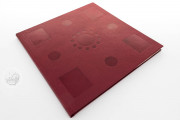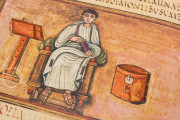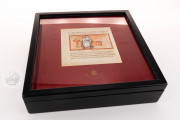Created in Rome around 480-490, the Roman Virgil—named in the sixteenth century for the Roman-ness of its stately Rustic Capital script—is a rare surviving late antique illustrated manuscript of a classical literary text. It comprises about three-quarters of a manuscript of the major works of the ancient Roman poet Virgil. Its surviving miniatures presage an approach that would become common in high medieval manuscripts: the placement of framed miniatures at the beginnings of new sections of text. It also boasts the earliest surviving example of a page of script with a painted frame to mark the start of a new text.
The manuscript is large, its parchment is of very high quality, and the text is expertly written. The execution of the paintings is less impressive, and the figures are awkwardly proportioned, although the painter seems to have developed skill while working on the book.
A Rare Illustrated Late Antique Manuscript
Nineteen of the original forty-two miniatures survive. The first, depicting Melboeus addressing Tityrus, is unframed with the unpainted parchment serving as background for the scene, a conservative approach consistent with that for illustrations on papyrus rolls. (fol. 1r). The other eighteen miniatures are innovative in having painted frames and backgrounds.
The first seven miniatures, which include three author portraits, occupy a quarter to a half of the page's height. The remaining twelve are full-page, including two pairs of miniatures on facing pages that form a single subject. One pair presents a bucolic scene of herders with their animals, and the other depicts a gathering of the ten major Roman deities (fols. 44v-45r and 234v-235r).
The Major Poems of Virgil
The Roman Virgil presents the Eclogues, the Georgics, and the Aeneid in the order in which they were composed, each longer than the previous. A single scribe wrote the verse text in long lines (i.e., a single column). Like the earlier Vatican Virgil, there is no space between the words.
Clear Articulation of Textual Divisions
Originally each of the four books of the Georgics and the twelve books of the Aeneid was preceded by a pair of facing full-page miniatures, which might form a single subject, but not necessarily. There is no text on the backs of the leaves with these miniatures, so they formed diptychs separated physically from the manuscript's text. For the Aeneid, the first three lines of each of the books were written in red, and verse summaries of the books were written in alternating lines of red and black (not all of either extant).
From Rome to Saint-Denis to the Vatican
The manuscript remained in Italy into the seventh century. It was probably at the royal monastery of Saint-Denis north of Paris as early as the ninth century, possibly bequeathed by the Holy Roman Emperor Charlemagne (742-814). It remained at Saint-Denis into the fifteenth century but was in the Vatican Library by 1475. The codex was confiscated in the Napoleonic wars and brought to the Bibliothèque nationale in Paris in 1797. It was returned to the Vatican in 1815, where it remains.
We have 1 facsimile edition of the manuscript "Roman Virgil": Vergilius Romanus facsimile edition, published by Belser Verlag, 1985
Request Info / Price

























